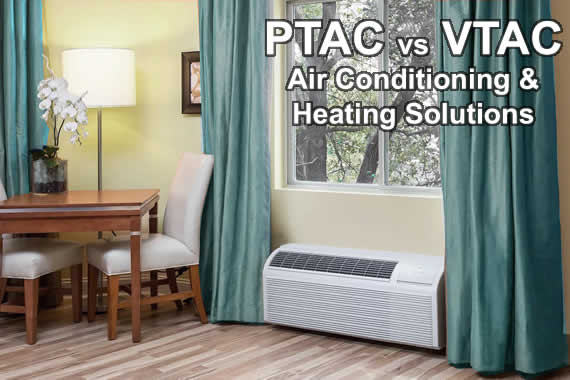PTAC vs VTAC: Heating and Cooling Solutions Explained
Perhaps you are considering an HVAC solution for an apartment building, motel or hospital and wanted to know which is best: PTAC or VTAC as a compact solution that is powerful enough to provide heat and cool when you need it.
However, you may not be sure what is the difference between the two types and which might be best for your project.
Many property owners find that their needs are different from certain other commercial projects.
What is needed is an effective heating and cooling solution that will ensure visitors to your property are kept in comfort without exceeding your budget.
 The two most common small size HVAC products that could fit your needs are PTAC and VTAC units.
The two most common small size HVAC products that could fit your needs are PTAC and VTAC units.
Let's look at the two of them, explain what they are and how they are different from each other along with how they can be the solution to your problem of providing heating and cooling within budget.
What is a PTAC?
A Packaged Terminal Air Conditioner (PTAC) is a standalone, self-contained air conditioning and heating unit that is installed through an exterior wall.
PTAC units are completely self-contained appliances. This means they do not need ducts or separate units (condenser and compressor) in order to operate.
They are a good option for heating or cooling a single room rather than investing in a large, central air system (HVAC) to service an entire home or building.
What is a VTAC?
A Vertical Terminal Air Conditioner (VTAC) is a vertically installed heating and air conditioning unit that is often located in a space that is hidden from view. This could be an existing closet or purpose-built storage space that can be closed off from the room.
A VTAC can operate to control the temperature either of just a single room or to service multiple rooms in a building.
Comparison: PTAC vs VTAC
The two similar sounding but differently designed small HVAC appliances are often found in similar settings. These include larger spaces such as apartment blocks, motels, hotels, hospitals etc.
Each type provides a good level of heating or cooling for the space it is installed in. The main difference between the two types of heating and air conditioning units is:
- PTAC is installed against (and into) the inside of an exterior wall, often below a window to make it easy to access by the occupant
- VTAC is installed inside an enclosed space such as a closet making it hidden from view.
They each have certain benefits and disadvantages as we will now cover.
PTAC Unit Benefits
- Low Cost: they are relatively inexpensive to purchase and on-going running costs can be lower too.
- Easy Installation: They are quite easy to install directly into an exterior wall, which appeals to property owners who need their rooms available for occupancy quickly
PTAC Unit Disadvantages
- Noise: In operation, they can be louder than other AC units, particularly modern mini-split AC units that can be whisper-quiet
- Limited: They can only operate in a single room where installed, not practical for cooling multiple rooms or moveable like portable air conditioners
VTAC Unit Benefits
- Powerful: These units are capable of controlling the temperature in multiple rooms and large areas
- Quiet: Operationally they are generally very quiet
- Out of Sight: Being installed in an enclosed space out of view, the room they occupy feels more homely
VTAC Unit Disadvantages
- Cost: They can cost more to purchase than other forms of air conditioners with heat
Summing Up
Both VTAC and PTAC units have their own advantages and are suited to different applications depending on your needs.
VTAC units are better suited for those preferring a more aesthetic installation where cost is not the overriding factor. By way of an example, a hotel owner might prefer to install VTAC units to provide for a more pleasant customer experience.
PTAC units are often preferred by those on a tighter budget who want a heating and cooling appliance that is relatively easy to install and has a lower running cost.
You can learn more about both these types of air conditioning and heating units right here on this website in related articles that I have linked to below:

